In the Footsteps of Gengis Khan in the Mongolian Steppe: Part 1
Bill Dennison ·From July 2nd- 4th, 2017, Simon Costanzo, Michele Thieme and I took a day to walk around the capital of Mongolia, Ulaanbaatar (Ulan Bator) and two days on driving tours to see both upstream and downstream sections of the Tuul River. This blog installment provides the first part of a synopsis of these field trips in anticipation of our Tuul River report card workshop.
Ulaanbaatar
Ulaanbaatar centers around a large public square. Behind this square is Parliament House. Surrounding this square and extending a few blocks to either side is beautiful old Mongolian architecture interspersed with stoic Soviet era buildings, modern high rise hotels, department stores and shops. Directly to the side of the government house is the National Museum of Mongolia. I enjoyed learning about the history of Mongolia from this museum from exhibits such as the Mongol Empire and the ger (rhymes with air) or Mongolian yurt. Gers are still used today by many Mongolians. After the Mongol Empire came the Soviet Era from 1929-1990. Looking at those dates, I realized just how young Mongolian democracy still is.

Mongolia honors its imperious past with statues of their great warlord, Ginggas Khaan (anglicized as Genghis Khan). The largest statue of him faced open public square, and my colleagues and I saw three different wedding parties posing with it. Elderly people in their ‘Sunday Best’ chatted and took photos with the statue. The traditional dresses that some of these women wore I found colorful and attractive. Other statues scattered throughout the downtown area included Marco Polo, the Venetian traveler who visited the court of Kublai Khan, Genghis Khan’s grandson, and notable Mongolians. Solely whimsical or artistic statues also populated the area.
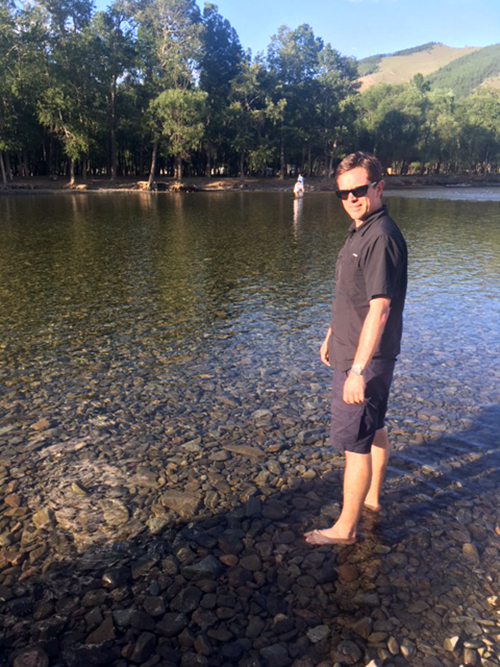
After admiring all of the different statues, we decided to visit a Buddhist temple. On the way to the temple, we passed several office buildings, including the Mongolian Supreme Court, but many of these buildings had been abandoned mid-construction. We also walked through some low cost housing. Some people in this area camped out in gers. Even though these people were very poor, they all seemed to have their needs taken care of; at least we saw none begging or homeless. When we arrived at the Buddhist temple, we saw people pray and light candles and learned about the impressive number of colleges in which taught different Buddhist doctrine.
Something that struck us during our travels that day was the Mongolian currency, called tughrik. Their economy is made entirely of paper money, and the current exchange rate is 1 Mongolian tughrik to 0.00042 USD. When we took money out of a bank machine, we would receive several large denomination bills, e.g., 20,000 tughriks. As we purchased things, we received a handful of smaller denominations such as 100 to 1,000 tughriks. As the day progressed, we would end up with a large wad of bills. However, these bills outside of America were almost worthless; At one point, I counted my collection of money and found that it was only worth 0.03 USD.
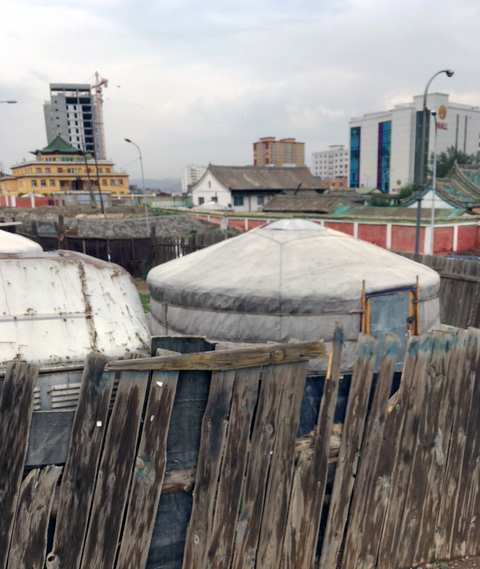
Upstream Tuul River
Our primary objective during this two-day journey was finding the triple continental divide. Located in central Mongolia, it is the intersection of three watersheds: Arctic Ocean via the Yeniesi River, and Pacific Ocean via the Amur River; these flow into the Central Asian Basin. Freshwater from the Central Asian Basin do not flow into the ocean. the rarity and importance of triple continental divides in watershed study made this one of interest, particularly because this one is the beginning of the Tuul River watershed.

Our principal tour guide for our destination was Purevdorj Surenkhorloo from WWF Mongolia. Like most Mongolians that we met, he went by a more pronounceable nickname, Puje. A woman from Tuul River Basin Authority, nicknamed Bati, also joined us. We drove a right-hand drive on the right side of the road, which was very unsettling. Changing lanes was an adventure because the driver couldn’t see around the vehicle being passed until the car was well into the other lane. While we drove a van with four wheeled drive, the Mongolians around us primarily drove Toyota Prius hybrid cars from Japan. The reason for the right-hand drive is that the Japanese, who drive on the left side of the road, sell their cars that do not meet stringent Japanese emission standards in Mongolia. However, the Mongolians appreciate the Toyota Prius hybrid’s fuel economy, ability to start in the cold Mongolian winters, and impressive off-road capabilities. Throughout the drive, we noted the strikingly blue sky and the way that the breezes kept us from getting too hot.
Our first stop was at a groundwater pumping station alongside the riparian zone of the Tuul River. We could see a line of white pumping stations, but they were protected by an armed guard who did not allow photographs.
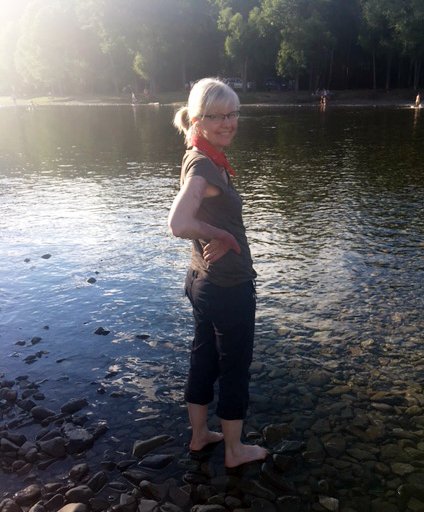
Our next stop was at a gigantic statue of Genghis Khan on horseback. This Genghis Khan Equestrian Statue is stainless steel and is 130’ (40 m) high. It faces in the direction of his birthplace, about 200 km away. At the base of the statue was a giant Mongolian boot and horse whip as well as a with a small museum and gift shop. We could also enter the statue, so we stepped inside and climbed to his horse’s head, where we had a sweeping view of the countryside. When we finished our tour of the statue, we saw a live vulture and golden eagle. Falconry is a Mongolian tradition, and to honor this the Mongolians erected a smaller statue of a Mongolian riding horseback with a falcon on his wrist.
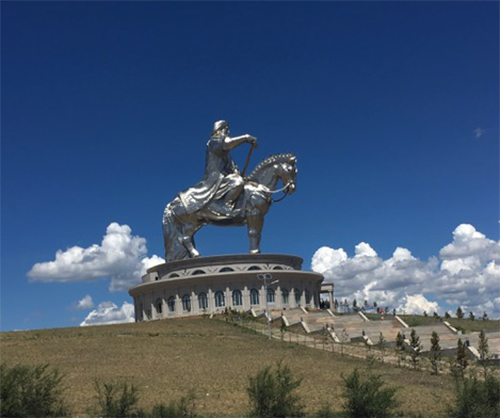
We stopped at a tourist camp for lunch and ate traditional Mongolian food on a veranda that overlooked the camp. The food in Mongolia would not suit a vegan. Meat and dairy predominated. After lunch, we watched several men construct bows and then practice archery. We learned that they were practicing for Naadam, a Mongolian national holiday. Ulaanbaatar empties out into the countryside, where there is singing and dancing in traditional costumes and sporting events like horseback riding, archery, and wrestling.
After lunch we continued driving. We stopped at an isolated ger to ask directions, and its occupant invited us all in for a chat and a taste of tangy homemade cheese from a communal bowl. Despite its lack of windows, I was impressed at how cool and comfortable it was in the ger. The only light in the ger came from the open door and a small skylight next to the stovepipe. The soft diffuse light, combined with the colorful cabinets and drawers lining the outer wall of the ger, made for a beautiful living space. The stove was powered by dried cow dung, but did not smell. The bedding materials were rolled up behind a cabinet. There was a television playing without sound, powered by a solar panel outside and a couple of large batteries. There was also a single light bulb hanging from the roof, which presumably ran off the batteries at night. There was a large plastic water container hanging suspended from the roof which acted as a weight to keep the roof in place.
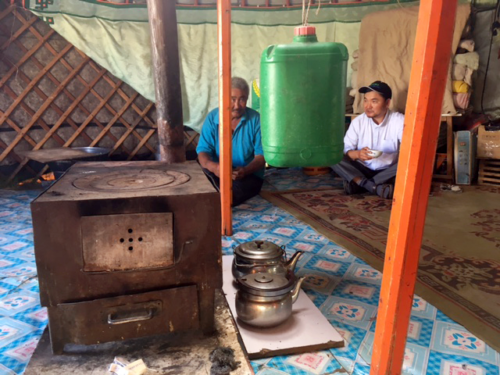
After some false leads, we located a faint track through the steppe to a monument that denoted the triple continental divide. The monument itself was a pillar with a globe on top and a plaque describing this location’s significance. It was located on a bluff overlooking some fairly rugged countryside. At this site, and at many sites alongside the road or on top of hills were large rock piles, called ovoos. The Mongolians showed us how to circle the ovoid three times in a clockwise direction. They also would toss three stones onto the ovoo, insuring that it grew over time. People left bits of cloth, food and money on the ovoo.

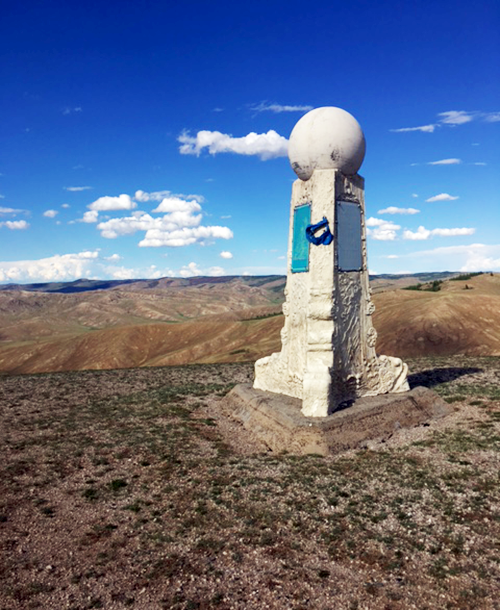
Our final stop was the Gorkhi-Terelj National Park in a more mountainous upstream region of the Tuul River. We waded out into the shallow river on the rocky stream bed. People brought their horses down to the water for a drink and children splashed around and had fun. The water was very chilly, even in the height of summer, which is not surprising considering it originated in permafrost landscapes. This was a wonderful way to end our field trip, standing in the clean, cool headwaters of the Tuul River.
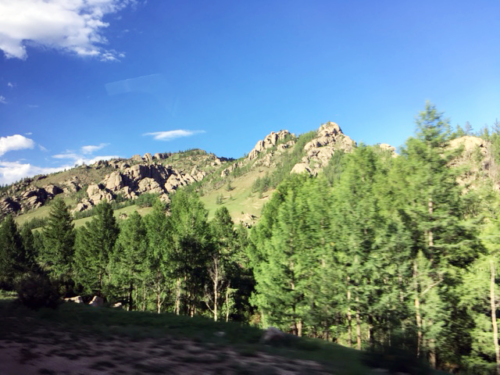
About the author
Bill Dennison

Dr. Bill Dennison is a Professor of Marine Science and Vice President for Science Application at the University of Maryland Center for Environmental Science.

